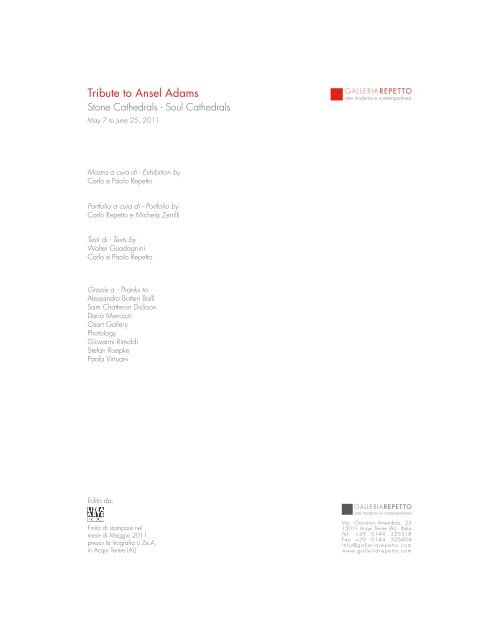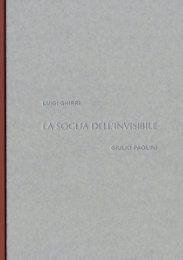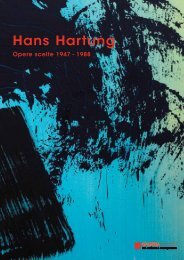Tribute to Ansel Adams - Galleria Repetto
Tribute to Ansel Adams - Galleria Repetto
Tribute to Ansel Adams - Galleria Repetto
You also want an ePaper? Increase the reach of your titles
YUMPU automatically turns print PDFs into web optimized ePapers that Google loves.
<strong>Tribute</strong> <strong>to</strong> <strong>Ansel</strong> <strong>Adams</strong><br />
S<strong>to</strong>ne Cathedrals - Soul Cathedrals<br />
May 7 <strong>to</strong> June 25, 2011<br />
Mostra a cura di - Exhibition by<br />
Carlo e Paolo Repet<strong>to</strong><br />
Portfolio a cura di - Portfolio by<br />
Carlo Repet<strong>to</strong> e Michela Zerrilli<br />
Testi di - Texts by<br />
Walter Guadagnini<br />
Carlo e Paolo Repet<strong>to</strong><br />
Grazie a - Thanks <strong>to</strong>:<br />
Alessandro Botteri Balli<br />
Sam Chatteron Dickson<br />
Daria Menozzi<br />
Osart Gallery<br />
Pho<strong>to</strong>logy<br />
Giovanni Rimoldi<br />
Stefan Roepke<br />
Paola Virtuani<br />
Edi<strong>to</strong> da:<br />
L I Z E A<br />
A R T E<br />
EDIZIONI<br />
Fini<strong>to</strong> di stampare nel<br />
mese di Maggio 2011<br />
presso la li<strong>to</strong>grafia Li.Ze.A.<br />
in Acqui Terme (AL)<br />
Via Giovanni Amendola, 23<br />
15011 Acqui Terme (AL) - Italia<br />
Tel. +39 0144 325318<br />
Fax +39 0144 326404<br />
i n f o @ g a l l e r i a r e p e t t o . c o m<br />
www.galleriarepet<strong>to</strong>.com
<strong>Tribute</strong> <strong>to</strong> <strong>Ansel</strong> <strong>Adams</strong><br />
S<strong>to</strong>ne Cathedrals - Soul Cathedrals<br />
May 7 <strong>to</strong> June 25, 2011<br />
“La visione di un monte le cui cime innevate si<br />
levano sopra le nubi, la descrizione dell’infuriare<br />
di una tempesta, oppure la rappresentazione del<br />
regno infernale di Mil<strong>to</strong>n suscitano piacere mis<strong>to</strong> a<br />
terrore; invece, l’occhio che spazia sui prati in fiore,<br />
valli percorse da rivi serpeggianti, disseminate di<br />
greggi al pascolo, la descrizione dell’Eliso oppure<br />
la raffigurazione di Venere in Omero, procurano<br />
anch’esse sensazioni deliziose, però liete e aperte al<br />
sorriso. Per far sì che le impressioni del primo tipo<br />
possano verificarsi in noi con la dovuta intensità,<br />
dobbiamo avere un sentimen<strong>to</strong> del sublime; per<br />
godere quelle del secondo tipo in modo adegua<strong>to</strong>,<br />
un sentimen<strong>to</strong> del bello”: quando Kant stende queste<br />
celebri righe, la fo<strong>to</strong>grafia è ancora là da venire,<br />
ma è indubbio che dopo la metà del XIX secolo ad<br />
essa verrà affida<strong>to</strong>, tra gli altri, anche il compi<strong>to</strong><br />
di testimoniare i luoghi inaccessibili e poetici dove<br />
il sentimen<strong>to</strong> del sublime poteva manifestarsi, e di<br />
portarli nelle case di quanti quell’esperienza potevano<br />
solo immaginarla.<br />
La fo<strong>to</strong>grafia di montagna, quella che trova i suoi<br />
rappresentanti massimi in Gustav Jägermyer, Adolphe<br />
Braun, nei Bisson e in Vit<strong>to</strong>rio Sella, si sviluppa<br />
infatti in<strong>to</strong>rno agli anni Sessanta dell’Ot<strong>to</strong>cen<strong>to</strong>, ed è<br />
parte di quel più vas<strong>to</strong> ambi<strong>to</strong> che si definisce come<br />
fo<strong>to</strong>grafia di viaggio: che si trattasse della spedizione<br />
nel Medio o nell’Estremo Oriente, o dell’ascesa su<br />
una qualche vetta alpina, motivazioni e condizioni<br />
operative avevano più di un pun<strong>to</strong> in comune.<br />
Deser<strong>to</strong> o ghiacciaio (anche nella sua forma estrema,<br />
quella polare), il fo<strong>to</strong>grafo doveva infatti superare<br />
difficoltà enormi sia nel traspor<strong>to</strong> dell’attrezzatura<br />
che nella realizzazione delle immagini, combattendo<br />
contro agenti atmosferici ancora troppo potenti per i<br />
materiali fo<strong>to</strong>grafici del tempo. Allo stesso modo, le<br />
spedizioni in continenti diversi o su catene montuose<br />
interne nascevano con intenti primariamente culturali<br />
e scientifici – documentari dunque in senso la<strong>to</strong> -, per<br />
divenire poi, al momen<strong>to</strong> della fruizione popolare,<br />
momenti di quell’appropriazione visiva dell’altro da sé<br />
che è parte integrante della fo<strong>to</strong>grafia sin dalle origini.<br />
Un altro da sé che, per ciò che riguarda la fo<strong>to</strong>grafia<br />
di montagna, è quell’elemen<strong>to</strong> naturale incontamina<strong>to</strong><br />
che già nell’Ot<strong>to</strong>cen<strong>to</strong> va scomparendo dall’orizzonte<br />
visivo e vitale dell’Occidente, da un la<strong>to</strong> sempre<br />
più racchiuso in una civiltà metropolitana, dall’altro<br />
impegna<strong>to</strong> ad addomesticare l’esperienza<br />
dell’incontro con l’altro attraverso la pratica del<br />
viaggio organizza<strong>to</strong> (che nasce praticamente in<br />
contemporanea con la fo<strong>to</strong>grafia...).<br />
Ciò vale tan<strong>to</strong> per la vecchia Europa che per la<br />
nuova America, con la differenza sostanziale che il<br />
panorama visivo statunitense – ed insieme ad esso<br />
la sua cultura – sono meno contaminati dal passa<strong>to</strong>,<br />
non vi sono i Turner e i Friedrich a fungere da pietra<br />
di paragone, da sublime pit<strong>to</strong>rico. E’ in quella cultura,<br />
che fa della frontiera il luogo mitico per la creazione<br />
dell’identità nazionale, che nasce, nei primi decenni<br />
del Novecen<strong>to</strong>, la fo<strong>to</strong>grafia di <strong>Ansel</strong> <strong>Adams</strong>, fulcro<br />
ideale della mostra odierna. Una fo<strong>to</strong>grafia che<br />
traduce il sublime in wilderness, e che concepisce<br />
la natura, probabilmente per l’ultima volta, come<br />
manifestazione del divino, luogo di una purezza<br />
ancora immaginata come possibile. L’Eden prima<br />
della comparsa dell’uomo, riprodot<strong>to</strong> con lo strumen<strong>to</strong><br />
ottico più affina<strong>to</strong> che l’uomo abbia inventa<strong>to</strong>. Una<br />
natura che parla un proprio linguaggio, fat<strong>to</strong> di<br />
simboli, di corrispondenze, di “manifestazioni”, come<br />
dirà qualche anno dopo Minor White.<br />
Quella di <strong>Adams</strong> è una fo<strong>to</strong>grafia classica, da<br />
ogni pun<strong>to</strong> di vista, in perfet<strong>to</strong> equilibrio tra ragioni<br />
tecniche e necessità espressive, ed è forse proprio<br />
perciò che ha lascia<strong>to</strong> pochi eredi diretti nel secondo<br />
dopoguerra, quando tut<strong>to</strong>, dai soggetti da riprendere<br />
agli atteggiamenti intellettuali, è irrimediabilmente<br />
muta<strong>to</strong>. Tan<strong>to</strong> che la montagna è, per alcuni<br />
anni, quasi scomparsa dall’orizzonte fo<strong>to</strong>grafico,<br />
sostituita da altri, più “civilizzati” e apparentemente<br />
complessi luoghi. Per <strong>to</strong>rnare, in<strong>to</strong>rno alla fine del<br />
secolo, ad attrarre artisti diversi, spinti da differenti<br />
motivazioni. Concentrandosi sull’attualità o sulla<br />
memoria, sull’analisi <strong>to</strong>pografica, presentandosi<br />
come riflessione sull’io e sulla società, la fo<strong>to</strong>grafia<br />
di montagna oggi non si sottrae al destino di ogni<br />
immagine, quello di non poter essere più innocente,<br />
ma di continuare a voler guardare, e indurre a<br />
guardare, il mondo, sublime o pit<strong>to</strong>resco, naturale o<br />
artificiale, che sia.<br />
Walter Guadagnini
<strong>Tribute</strong> <strong>to</strong> <strong>Ansel</strong> <strong>Adams</strong><br />
S<strong>to</strong>ne Cathedrals - Soul Cathedrals<br />
May 7 <strong>to</strong> June 25, 2011<br />
Omaggio ad <strong>Ansel</strong> <strong>Adams</strong><br />
Cattedrali di pietra - Cattedrali dell’anima<br />
La nostra famiglia, da sempre appassionata della montagna, ha il piacere di presentare ques<strong>to</strong> particolare<br />
omaggio ai templi del ghiaccio e delle rocce. Un tribu<strong>to</strong> ad <strong>Ansel</strong> <strong>Adams</strong>, una mostra collettiva di fo<strong>to</strong>grafie<br />
dal ti<strong>to</strong>lo Cattedrali di pietra - Cattedrali dell’anima. Un elogio ai luoghi dell’altitudine, agli spazi della<br />
vertigine: un inno alle dimore delle divinità, alla casa degli dei. Abbiamo così raccol<strong>to</strong> una trentina<br />
di opere del grande maestro americano e altri lavori s<strong>to</strong>rici di Minor White, Mario Gabinio, Vit<strong>to</strong>rio<br />
Sella, Albert Steiner, (cattedrali di pietra); insieme ad altre fo<strong>to</strong>grafie, dedicate alla particolare poetica,<br />
introspettiva e concettuale, (cattedrali dell’anima) di Luigi Ghirri, Richard Long ed Hamish Ful<strong>to</strong>n. Immagini,<br />
simboli e poetiche che dialogano e si intersecano fino ai contemporanei Luca Andreoni, Olivo Barbieri,<br />
Edward Burtynsky, Luca Campigot<strong>to</strong>, Olafur Eliasson,Thomas Joshua Cooper, Daniele De Lonti, Naoki<br />
Ishikawa, Bernard Plossu.<br />
E’ un piacere poter testimoniare del magico occhio della fo<strong>to</strong>grafia, che indaga la natura come luogo<br />
divino. La montagna come un’epifania (manifestazione del sacro). Le rocce, il cielo, le nuvole, la luna, i<br />
ghiacci, i laghi, gli alberi, i prati, l’immenso orizzonte come segni di una divinità pervasiva e nascosta,<br />
presente e misteriosa. Gli arabeschi delle pietre, i geroglifici di una corteccia, gli ideogrammi dei ghiacciai;<br />
le infinite lettere dell’universo in una simbologia senza tempo; l’immenso libro dell’aria dove le rocce e le<br />
nuvole appaiono come una scrittura semplice e felicemente indecifrabile.<br />
Paolo e Carlo Repet<strong>to</strong>
<strong>Tribute</strong> <strong>to</strong> <strong>Ansel</strong> <strong>Adams</strong><br />
S<strong>to</strong>ne Cathedrals - Soul Cathedrals<br />
May 7 <strong>to</strong> June 25, 2011<br />
“The vision of a mountain, the summit of which<br />
is surrounded by clouds, the description of an<br />
infuriating thunders<strong>to</strong>rm, or the representation of<br />
Mil<strong>to</strong>n’s infernal reign, arise feelings of pleasure<br />
and fear at the same time; on the other hand an<br />
eye spacing from blossoming meadows, <strong>to</strong> valleys<br />
crossed by streams and rivers, full of animals<br />
pasturing, the description of the Elisha or Venus’<br />
representation in Homer’s works, arise delicious<br />
sensations, joyous and peaceful. In order <strong>to</strong> make<br />
the impressions of the first kind occur, with the right<br />
intensity, we need <strong>to</strong> have a sublime sentiment; and<br />
<strong>to</strong> enjoy those of the second kind, we need the<br />
sentiment of beauty”: when Kant wrote these famous<br />
lines, pho<strong>to</strong>graphy was far from being invented,<br />
but with no doubt after mid XIX century the task of<br />
recording the inaccessible and poetic spaces where<br />
the emotion of the sublime could arise, was given<br />
<strong>to</strong> pho<strong>to</strong>graphy, which was able <strong>to</strong> bring those<br />
emotions <strong>to</strong> all those who could not even imagine<br />
them. Mountain pho<strong>to</strong>graphy, of which the greatest<br />
exponents are Gustav Jägermyer, Adolphe Braun,<br />
the Bissons and Vit<strong>to</strong>rio Sella, develops around<br />
1860 and is part of the vastest category of journey<br />
pho<strong>to</strong>graphy: from the expeditions in the Far and<br />
the Middle East, <strong>to</strong> the climbing of a summit, where<br />
reasons and conditions are what all journeys have<br />
in common. Deserts or glaciers (even in its extreme<br />
polar shape), the pho<strong>to</strong>grapher had <strong>to</strong> face extreme<br />
difficulties <strong>to</strong> carry his equipment and <strong>to</strong> impress an<br />
image, fighting against atmospheric agents, <strong>to</strong>o<br />
powerful for the pho<strong>to</strong>graphic equipment at that<br />
time. In the same way, the expeditions abroad or<br />
on inland mountains chains departed from cultural<br />
and scientific purposes – documentary – yet <strong>to</strong><br />
become, when enjoyed by the people, visual<br />
appropriation of the other from the self, which is<br />
an integral aspect of pho<strong>to</strong>graphy since its origins.<br />
Another important feature of mountain pho<strong>to</strong>graphy,<br />
is the natural and uncontaminated element which<br />
even back in XIX century was getting lost from<br />
the visual and vital horizon in the West, which<br />
was locking itself in a metropolitan civilization,<br />
whilst on the other hand it was committed <strong>to</strong> tame<br />
the experience of meeting the other throughout<br />
package <strong>to</strong>urs (which were born contemporarily <strong>to</strong><br />
pho<strong>to</strong>graphy…).<br />
This was important <strong>to</strong> the Ancient world – Europe,<br />
and <strong>to</strong> the New World – America, with the basic<br />
difference that American landscapes, <strong>to</strong>gether with<br />
its culture, were less contaminated with the past:<br />
no Turner and no Friedrich as a term of comparison<br />
for sublime painting. In this culture, which takes the<br />
idea of the border and turns it in<strong>to</strong> a mythic place<br />
for the creation of a national identity, <strong>Ansel</strong> <strong>Adams</strong><br />
starts <strong>to</strong> take pho<strong>to</strong>graphs, at the beginning of the<br />
century. A pho<strong>to</strong>graphy which translates the sublime<br />
in wilderness, which conceives nature, maybe for<br />
the last time, as a divine demonstration, a pure and<br />
fantastic space in which he still believes. The Eden,<br />
before mankind appeared, registered with the most<br />
fine optical instrument man ever invented. A nature<br />
speaking its own language, made of signs, of<br />
correspondences, of “demonstrations”, as someone<br />
will call them years after Minor White.<br />
<strong>Adams</strong>’ is a classical pho<strong>to</strong>graphy, from all points<br />
of view, where technical reasons and expressive<br />
necessities are in perfect balance, and this may<br />
be the reason for not having found direct heirs<br />
during the Second Postwar, when everything, from<br />
subjects <strong>to</strong> intellectual attitudes <strong>to</strong> record, were<br />
irreparably mutated. This <strong>to</strong> the point that mountains<br />
disappeared from the pho<strong>to</strong>graphic horizon,<br />
substituted by other more “civilized” and apparently<br />
more complex places, though around the end of<br />
the century, different artists felt attracted <strong>to</strong> it again,<br />
for different reasons. Concentrating on the present<br />
and the memory of the past, on the <strong>to</strong>pographic<br />
analysis, presenting itself as a reflection on man<br />
and society, <strong>to</strong>day mountain pho<strong>to</strong>graphy does not<br />
subtract <strong>to</strong> every image’s fate, that of not being<br />
innocent anymore, but that of continuing wanting <strong>to</strong><br />
watch, and inducing <strong>to</strong> watch the world, whether<br />
picturesque or sublime, natural or artificial.<br />
Walter Guadagnini
<strong>Tribute</strong> <strong>to</strong> <strong>Ansel</strong> <strong>Adams</strong><br />
S<strong>to</strong>ne Cathedrals - Soul Cathedrals<br />
May 7 <strong>to</strong> June 25, 2011<br />
<strong>Tribute</strong> <strong>to</strong> <strong>Ansel</strong> <strong>Adams</strong><br />
S<strong>to</strong>ne cathedrals - Soul cathedrals.<br />
Our family has always been passionate about mountains, and has the pleasure <strong>to</strong> present this particular<br />
homage <strong>to</strong> the cathedrals of Rocks and Ice. A tribute <strong>to</strong> <strong>Ansel</strong> <strong>Adams</strong>, a collective exhibition of pho<strong>to</strong>s<br />
called “S<strong>to</strong>ne cathedrals – Soul cathedrals”. A praise <strong>to</strong> altitude spaces, spaces of vertigo: a hymn <strong>to</strong><br />
the divinities’ mansion, the house of gods. A collection of more than thirty pieces of art of the great<br />
American master and other important works by Minor White, Mario Gabinio, Vit<strong>to</strong>rio Sella, Albert Steiner,<br />
(s<strong>to</strong>ne cathedrals); with other pictures, dedicated <strong>to</strong> the particular, conceptual and introspective poetic (soul<br />
cathedrals) by Luigi Ghirri, Richard Long and Hamish Ful<strong>to</strong>n. Images, symbols and poetics which dialogue<br />
and are woven <strong>to</strong>gether with contemporaries like Luca Andreoni, Olivo Barbieri, Edward Burtynsky, Luca<br />
Campigot<strong>to</strong>, Thomas Joshua Cooper, Daniele De Lonti, Naoki Ishikawa, Bernard Plossu.<br />
It is a pleasure <strong>to</strong> experience the magical eye of pho<strong>to</strong>graphy, which probes nature as a divine space.<br />
Mountain as epiphany (sacred demonstration). Rocks, sky, clouds, moon, lakes, trees, meadows, and<br />
the immense horizon, as signs of a pervasive and hidden divinity, present and mysterious at the same<br />
time. S<strong>to</strong>nes’ arabesques, bark hieroglyphs, glaciers’ ideograms; the infinite letters of universe create a<br />
symbology out of time, and the immense book of air, where rocks and clouds appear as a simple scripture,<br />
happily indecipherable.<br />
Paolo and Carlo Repet<strong>to</strong>
ichard long
albert steiner
hamish ful<strong>to</strong>n
naoki ishikawa
luca andreoni
olivo barbieri
ansel adams
ernard plossu
luigi ghirri
olafur eliasson
daniele de lonti
edward burtynsky
mario gabinio
luca campigot<strong>to</strong>
minor white
thomas joshua cooper
vit<strong>to</strong>rio sella
<strong>Tribute</strong> <strong>to</strong> <strong>Ansel</strong> <strong>Adams</strong><br />
S<strong>to</strong>ne Cathedrals - Soul Cathedrals<br />
May 7 <strong>to</strong> June 25, 2011<br />
Albert Steiner<br />
Piz Palü - Bellavista - Berninagruppe<br />
Gelatin silver print, 16,5 x 22,6 cm<br />
<strong>Ansel</strong> <strong>Adams</strong><br />
Moon and half dome, 1960<br />
Gelatin silver print, 50 x 38,8 cm<br />
Bernard Plossu<br />
Dibona alpes, 2003<br />
Gelatin silver print, 24 x 30 cm<br />
Edward Burtynsky<br />
Carrara marble quarries 26, Carrara, Italy<br />
1993, C print, 101,6 x 127 cm<br />
Daniele De Lonti<br />
Monviso #03<br />
Colorprint, 58 x 70 cm<br />
Mario Gabinio<br />
Rocciamelone. Dalla cresta della Resta<br />
Stampa alla gelatina d’argen<strong>to</strong>, 22,4 x 17,4 cm<br />
Hamish Ful<strong>to</strong>n<br />
Fallen branches on a deer path, 1985<br />
C print + text, 131 x 81 cm<br />
Luca Andreoni<br />
Non si fa in tempo ad avere paura, Crepacci<br />
2008/2009<br />
C print in plexiglass/alluminio dibond, 125 x 98 cm<br />
Luca Campigot<strong>to</strong><br />
Strada degli eroi, Pasubio, 1995<br />
Stampa ai pigmenti, 110 x 135 cm<br />
Luigi Ghirri<br />
Salisburgo,1977<br />
Vintage colour print, 10 x 15 cm<br />
Minor White<br />
Waterfall, Vermont, 1970<br />
Stampa ai sali d’argen<strong>to</strong>, 35,2 x 27,5 cm<br />
Naoki Ishikawa<br />
Mt. Fuji 38, 2008<br />
C print mounted on plexiglass board, 90 x 112 cm<br />
Olafur Eliasson<br />
Landscapes,1995<br />
8 colour coupler prints, 22,5 x 30 cm each<br />
Olivo Barbieri<br />
Site specific CATANIA, 2009<br />
Jnkjet print on archival paper, 111 x 146,1 cm<br />
Richard Long<br />
The s<strong>to</strong>nes sink slowly with the melting ice of<br />
summer along a four day walk in Norway<br />
1973, Black and white pho<strong>to</strong>graphy, 83 x 113,5 cm<br />
Thomas Joshua Cooper<br />
A premonitional work message <strong>to</strong> Timothy<br />
H. O. Sullivan canon del Muer<strong>to</strong> Antelope<br />
Ruins, Navajo Tribal Terri<strong>to</strong>ry, Arizona, U.S.A.<br />
1994/1995, Gelatin silver print, 43 x 60 cm<br />
Vit<strong>to</strong>rio Sella<br />
North side of Jannu from Kaybachen with<br />
the Yamatari Glacier, Nepal, 1899<br />
Vintage collodion paper print, 23,5 x 17,5 cm





